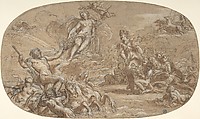The Birth of Venus, with Neptune, Cybele and the Chariot of the Sun (Homage to Venus)
Niccolò Berrettoni Italian
Not on view
Born in the Marche and trained under the guidance of the local master Simone Cantarini (1612-1648), Niccolò Berrettoni moved to Rome in 1650 and, still under aged, soon joined the workshop of Carlo Maratti (1625-1713), at the time the most renowned painter of the city. This drawing, depicting the Homage to Venus with Neptune and Cybele, a sophisticated mythological subject, can be precisely connected with the fresco that adorns the ceiling of the main hall of Villa Falconieri at Frascati, a town just outside of Rome. Painted by Berrettoni during the 1670's, the fresco have been considered for a long time as a work by Carlo Maratti himself, until Anthony M. Clark attributed it to his pupil ("A ‘Lost’ Fresco by Niccolò Berrettoni,’ in The Connoisseur, no. CXLVIII, 1961, pp.190-93). As the inscription on the bottom right of the sheet reads, the Museum’s drawing was also misattributed to Maratti by an early collector - possibly Pierre Crozat or Jean Denis Lempereur . Shortly before this commission, the Villa - formerly known as Villa Rufini - was acquired by the Florentine nobleman Orazio Falconieri (d. 1664), who commissioned its architectural renovation to Francesco Borromini (Francesco Castelli, 1599-1667). Berrettoni's fresco survives today, although in a highly damaged state, following a dramatic bombing of the Villa in 1943 during the Second World War (a photograph of the original fresco is in the Image Library of the Fondazione Federico Zeri, Bologna, no. 0490, folder 3).
(Furio Rinaldi)
Due to rights restrictions, this image cannot be enlarged, viewed at full screen, or downloaded.



